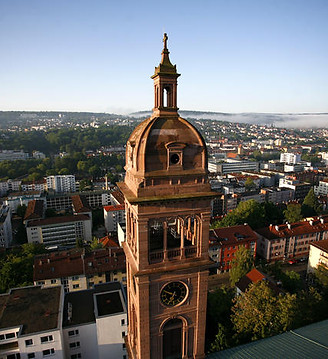GENERAL INFORMATION
Pforzheim is a city in the northwest of Baden-Württemberg on the northern edge of the Black Forest. That is why Pforzheim is also called "Gateway to the Black Forest". Numerous Black Forest hiking trails begin here. In addition, the three rivers Enz, Nagold and Wurm meet here. The banks of the three rivers are ideal for a relaxing walk, to meet friends or to read a book away from the hustle and bustle of learning. With about 120,000 inhabitants, Pforzheim is the eighth largest city in Baden-Württemberg. It is enclosed by the two large cities Karlsruhe, northwest, and the state capital Stuttgart, southeast. Mayor of the city Pforzheim is Peter Boch.

ACTIVITIES
Due to its location between the two big cities Stuttgart and Karlsruhe, Pforzheim is perfect for city trips. But also excursions into the nature, like the neighbouring Black Forest with numerous offers, like hikes or the treetop path are to be recommended. The city of Pforzheim also offers a wide range of cultural and leisure activities, such as numerous museums, concerts and theaters as well as annual events, such as the Pforzheim Fair with a large firework at the end and a Christmas market with a mediaeval market.

HISTORY
Today's Pforzheim developed from a small Roman settlement, which was founded around the year 90 AD. As a small pier on the Enz, it was called Portus (Latin for "harbour"). This is also the origin of Pforzheim's current name as "Gate to the Black Forest".
1718, Margrave Karl-Friedrich built a clock factory there to employ the children of the orphanage. Some time later, the production of jewellery was added. Pforzheim became an industrial city and experienced an economic heyday as a city of jewellery and gold. Today, the orphanage is regarded as the cornerstone of the Pforzheim jewellery and watch industry. It is the most important location for gold and silverware production in Germany. This is referred to the name affix as the Gold and Jewellery City. Around 75 percent of German jewelry is produced in the city. In addition, the only school of goldsmithing with a watchmaking school in Germany is located here.
The British air raid on Pforzheim on 23rd February 1945 destroyed 80 percent of the city within 20 minutes. Around 18,000 people died during the bombing and it took 40 years to completely repair the damage and restore the city to its former glory. Complaints about an uneven and unattractive cityscape still affect the image of the city. They are often attached to the reconstruction of Pforzheim in the sober style of post-war modernism in the late 1940s and early 1950s, which was oriented towards functionalism. The lack of a classical representative old town due to the multiple urban destruction and internal shifts in the main settlements had been noticed negatively in Pforzheim.



